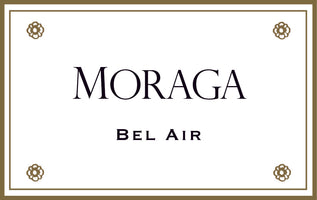The Vineyard

The canyon locale of the Moraga Bel Air vineyard includes ancient marine soils and a distinct microclimate that clearly differentiates the property from other California appellations. The steep vineyard, planted at elevations up to 900 feet, is recognized as an exceptional site for creating wines with a sense of place. A daily “bay breeze” coming off the Santa Monica Bay, which can be clearly seen in the distance from the top of the vineyard, keeps vineyard temperatures moderate. The character of the vineyard is strongly reflected in the wines; in the Moraga Red, the calcareous soils connect each vintage with a common thread. There is a unique and identifiable Moraga signature of rich tannins; supple texture, pure Cabernet fruit, currant and tobacco. Grapes from the vineyard’s many different exposures allow us to build complexity from a careful blend of the different vineyard blocks that make up the vineyard.
The overriding objective of grape growing practices at Moraga Vineyards is to produce the best possible fruit in a sustainable manner. Most of the vineyard is closely spaced on sloping hillsides that are inaccessible to tractors and other equipment. As a result, all of the vineyard work, from pruning to picking, is done by hand by a year-round crew of eight people. There are 6.9 planted acres on the 14-acre property: 4.3 acres of Cabernet Sauvignon, 1.2 acres of Merlot, one tenth of an acre of Petite Verdot, one tenth of an acre of Cabernet Franc and slightly over 1 acre of Sauvignon Blanc.

Rootstocks were chosen to match the unique characteristics of the site. Rootstock 3309 is selected for its non-vigorous nature on the less calcareous soils. The rootstock 101-14 is matched with Sauvignon Blanc on the gravel-underlain soils of the canyon floor. The Cabernet Sauvignon clones 337 and 04, and Merlot clone 181 were selected for their long track record of producing high-quality fruit with low-yields. The cuttings for our Petite Verdot and the Cabernet Franc plantings were hand-selected from David Abreu’s world-class vineyards in Napa Valley. The Sauvignon Blanc is now entirely Clone 1, the result of years of trial and error.
The vineyard’s unique microclimate differs from the surrounding area. Records from the last 45 years indicate the average rainfall in the canyon is 24 inches, compared to local averages of 15 inches. These records also show that although the average daytime temperature is somewhat cooler than that of other parts of Los Angeles, and nighttime temperatures are considerably cooler, by about six to eight degrees. The cold winter nights typically cause the vines to become dormant from the beginning of December until mid-March.
 The Moraga vineyard is viewed as a total ecosystem, rather than a grape monoculture. Areas of native vegetation and the extensive gardens serve as insectaries for beneficial insects. A permanent cover crop of native grasses and wildflowers is maintained in order to prevent erosion and improve overall soil health. Surrounding the vineyard, a handcrafted stone wall enhances the sense of place. This Bordeaux-style vineyard in the heart of Bel Air is legendary as it is one of the first new commercial vineyards since Prohibition ended in the city of Los Angeles.
The Moraga vineyard is viewed as a total ecosystem, rather than a grape monoculture. Areas of native vegetation and the extensive gardens serve as insectaries for beneficial insects. A permanent cover crop of native grasses and wildflowers is maintained in order to prevent erosion and improve overall soil health. Surrounding the vineyard, a handcrafted stone wall enhances the sense of place. This Bordeaux-style vineyard in the heart of Bel Air is legendary as it is one of the first new commercial vineyards since Prohibition ended in the city of Los Angeles.
